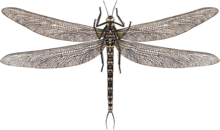
Back يعسوبيات ضخمة Arabic Meganisòpters Catalan Meganisoptera CEB Meganisoptera German Protodonata Spanish شیردالمگسسانان Persian Meganisoptera French Meganisópteros Galician מגאניסופטרה HE Protodonata Italian
| Meganisoptera Temporal range:
| |
|---|---|

| |
| Reconstruction of Meganeurites gracilipes | |
| Scientific classification | |
| Domain: | Eukaryota |
| Kingdom: | Animalia |
| Phylum: | Arthropoda |
| Class: | Insecta |
| Superorder: | Odonatoptera |
| Order: | †Meganisoptera Martynov, 1932 |
| Families | |
| |
| Synonyms | |
| |
Meganisoptera is an extinct order of large dragonfly-like insects, informally known as griffenflies or (incorrectly) as giant dragonflies. The order was formerly named Protodonata, the "proto-Odonata", for their similar appearance and supposed relation to modern Odonata (damselflies and dragonflies). They range in Palaeozoic (Late Carboniferous to Late Permian) times. Though most were only slightly larger than modern dragonflies, the order includes the largest known insect species, such as the late Carboniferous Meganeura monyi and the even larger early Permian Meganeuropsis permiana, with wingspans of up to 71 centimetres (28 in).[1]

The forewings and hindwings are similar in venation (a primitive feature) except for the larger anal (rearwards) area in the hindwing. The forewing is usually slenderer and slightly longer than the hindwing. Unlike the true dragonflies, the Odonata, they had no pterostigmata, and had a somewhat simpler pattern of veins in the wings.
Most specimens are known from wing fragments only; with only a few as complete wings, and even fewer (of the family Meganeuridae) with body impressions. These show a globose head with large dentate mandibles, strong spiny legs, a large thorax, and long and slender dragonfly-like abdomen. Like true dragonflies, they were presumably predators.
A few nymphs are also known, and show mouthparts similar to those of modern dragonfly nymphs, suggesting that they were also active aquatic predators.[3]
Although sometimes included under the dragonflies, the Meganisoptera lack certain distinctive wing features that characterise the Odonata. Grimaldi & Engel 2005 point out that the colloquial term "giant dragonfly" is therefore misleading, and suggest "griffenfly" instead.
- ^ Grimaldi & Engel 2005, p. 175.
- ^ Tillyard 1917, p. 324: "No Dragonfly at present existing can compare with the immense Meganeura monyi of the Upper Carboniferous, whose expanse of wing was somewhere about twenty-seven inches."
- ^ Hoell, Doyen & Purcell 1998, p. 321.